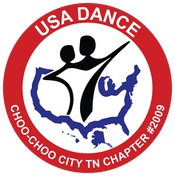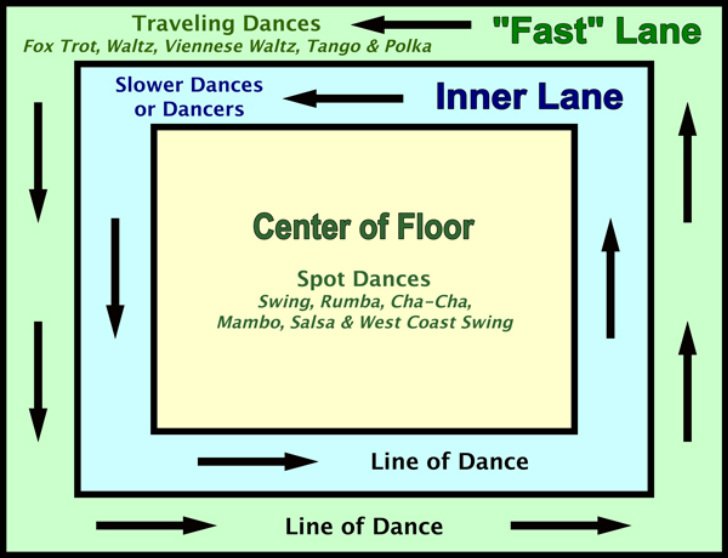Dance Etiquette
Tips to help everyone have a great time.
-
Description text goes hereWhen you ask someone to dance, be sure to make eye contact with your prospective partner, offer your hand, and ask clearly, “Would you like to dance?” If your partner says yes, smile, offer your hand, and escort him or her onto the dance floor and into dance position. This will make your partner feel supported and at ease.
-
When someone asks you to dance, your response should be, “Yes, thank you, I’d love to.” In a social dance environment, it is customary to say “yes” when someone asks you to dance. In order for dancing to be a joyous activity, it is important that social dancers are supportive and kind to each other at all skill levels.
-
During the dance, be sure to be aware of your partner. Smile and make eye contact, but don’t stare. It is fun to dance with a partner who is gracious and appreciative. At the end of the dance, ALWAYS say THANK YOU to your partner and begin to escort them off the floor.
-
When a person asks you to dance, it is appropriate to say no if you have danced with this person before and he or she has been physically or verbally abusive. It is also appropriate to say no if the person is obviously drunk or threatening in some way. If you feel that a dancer is physically dangerous to the other dancers, you should report the situation immediately to a chapter board member.
Unless someone is truly offensive, it is not appropriate to say no because your partner may have poor dance technique. While dancing with this person may not be one of life’s peak experiences, a dance is only three minutes long and the experience will not kill you.
-
Unless someone asks you directly to make a correction of their dancing, you should never volunteer criticisms of your dance partner’s technique. Know that your dance partner is doing the best he or she can.
If your partner is dancing off time, you should view the situation as a challenge to dance to the same internal rhythms as your partner. Your partner is not dancing off time intentionally. Again, he or she is doing the best he or she can. Do your best to respect each others rhythms.
If your partner is physically hurting you, it is probably inadvertent. You should stop dancing for a second, and say “I’m sorry, but you’re holding my hand a little tightly. Could we try again?” If you receive an inconsiderate response or your partner seems unwilling to modify his behavior, it is then appropriate to say, “thank you, but I’d like to stop now.” Social dancing should never be physically painful or dangerous.
In a social dance situation it is appropriate to dance with a variety of people. It is generally poor dance etiquette to partner up and dance with the same person all evening long. Naturally, some people will prefer certain dance partners to others, but this should not prevent them from accepting an offer to dance from a new person.
If the same person asks you to dance repeatedly, for several dances in a row, it is acceptable to tell that person, “thank you, but I’d like to meet and dance with some other people for awhile. I’ll be happy to dance with you again later in the evening.”
-
Social dancing is a quasi-intimate activity that requires a certain degree of physical closeness. Good hygiene shows respect and consideration for the other dancers. Dancers should bathe, use deodorant, use breath mints, and wear clean clothes that will not be too hot.
Some dancers sweat a great deal while dancing. In this case, it is considerate to bring a towel and/or change of clothes. If you find yourself getting too sweaty on the dance floor, you should stop, dry off, and cool down for a few minutes. Your partners will thank you for it. Dancers should also use a light touch applying perfume or cologne. Some people may be sensitive to fragrances.
-
In order for a social dance to be enjoyable for all participants, it is crucial to be considerate and aware in your floor craft. No matter how much you may want to swing out, on a crowded dance floor your primary consideration should be respect for the other couples on the floor. You don’t have to dance big to have fun.
At times, collisions do occasionally occur in the heat of the moment. When there is a collision, everyone involved should stop and apologize, regardless of whose “fault” it was. If someone has been hurt, you should make sure that person is okay before you resume dancing. Sometimes people are not okay after a collision. In this case, you should escort the person off the floor to a chair and see if that person needs ice, a drink of water or medical attention. Careful observation of the traffic lanes in a ballroom can prevent mishaps.
In Waltz, Foxtrot, Tango, Quickstep, and Samba, dancers move in a counterclockwise circle around the floor. This circle is known as “line of dance”. The very outside lane of the line of dance is the “fast" lane; it is generally used by very experienced dancers who cover a great deal of ground. The inside lane is for less experienced dancers who may be moving a bit more slowly. Beginners and those who would like to practice the basic steps without traveling can stay on the inside of the circle, out of the line of dance completely.
In addition, it is considered inappropriate to cut across the dance floor, especially when carrying food or drink. And also, remember to move off the dance floor when engaged in conversation.

